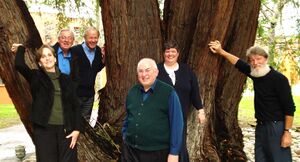Seeds of Change Chapter 1: Introduction
From Vincentian Family News Blog's introduction to the Systemic Change: Seeds of Change series: Pope John Paul II encouraged people to analyze the situation of the poor carefully, to identify the structural roots of poverty, and to formulate concrete solutions.This week, we begin a 20-week series, offered by the members of the Commission for Promoting Systemic Change, about strategies that are useful, often even essential, for bringing about such change.
Adopting as its starting point a group of projects in which systemic change has actually taken place, the Commission analyzed stories of leaders of successful projects. From these stories, the Commission sought to identify the strategies that helped produce lasting change.It soon became clear that many of the strategies that led to structural changes and transformed the circumstances of individuals and communities flowed from the Gospels and from our Vincentian tradition.
Systemic Change Strategy 1: Consider poverty not merely as the inevitable result of circumstances, but also as the product of unjust situations that can be changed, and focus on actions that will break the cycle of poverty.
by Robert Maloney, C.M.

In an address given in New York on Oct. 2, 1979, Pope John Paul II encouraged his listeners to analyze the situation of the poor carefully, to identify the structural roots of poverty, and to formulate concrete solutions:
Social thinking and social practice inspired by the Gospel must always be marked by a special sensitivity towards those who are most in distress, those who are extremely poor, those suffering … from hunger, neglect, unemployment and despair. You will also want to seek out the structural reasons which foster or cause the different forms of poverty in the world and in your own country, so that you can apply appropriate remedies.
This series, offered by the members of the Commission for Promoting Systemic Change, about strategies that are useful, often even essential, for bringing about such change.
The strategies that will be described in this series are not the product of abstract reflection; they are the fruit of practical experience. The Commission, adopting as a starting point a group of projects in which systemic change has actually taken place, analyzed the project leaders’ stories and then sought to identify the strategies that helped produce lasting change. It soon became clear that many of the strategies that led to structural changes and transformed the circumstances of individuals and communities flowed from the Gospels and from our Vincentian tradition.
For practical and pedagogical reasons, the Commission grouped the strategies which they identified into four categories. In many cases, the strategies overlap and interact with one another:
- 1. Mission-oriented strategies, which focus on direction and motivation;
- 2. Task-oriented strategies, which focus on organization;
- 3. People-oriented strategies, which focus on the poor themselves as the persons who are most capable of changing their own situation;
- 4. Strategies which focus on co-responsibility, networking and political action and which emphasize participation and solidarity.
The first group, called mission-oriented strategies, is closely linked to our Vincentian identity and, in fact, consistently influences Vincentian projects. Today we will look at the first of these mission-oriented strategies:
Consider poverty not merely as the inevitable result of circumstances, but also as the product of unjust situations that can be changed, and focus on actions that will break the cycle of poverty.
This strategy aims at developing an attitude; namely, seeing the cycle of poverty as breakable rather than inevitable. Without this conviction, nothing will happen. The U.N. Millennium Development Goals affirm that the world possesses more than enough material goods to satisfy the needs of all members of the human race. The poor remain poor largely because of changeable economic and social structures that favor the interest of the strongest and work to the detriment of the weakest.

Pope John Paul II wrote in Solicitudo rei socialis (16):
“One must denounce the existence of economic, financial and social mechanisms which, although they are manipulated by people, often function almost automatically, thus accentuating the situation of wealth for some, and poverty for the rest. These mechanisms, which are maneuvered directly or indirectly by the more developed countries, by their very functioning favor the interests of the people manipulating them and in the end they suffocate or condition the economies of the less-developed countries.”
It is essential that individuals and groups work to change such structures. Poverty can be eradicated only by building just social structures in which the poor have equal access to education, employment, housing, health care, nutrition and other basic human needs. In an address given in February 2005 at Trafalgar Square during a rally aimed to “Make Poverty History,” Nelson Mandela noted: “Like slavery and apartheid, poverty is not natural. It is a human creation and it can be overcome and eradicated by the actions of human beings. Overcoming poverty is not a gesture of charity – it is an act of justice. It is my wish that this award helps activists around the world to shine their candle of hope for the forgotten prisoners of poverty.”
Fredrick Ozanam, the principal founder of the Society of St. Vincent de Paul, made precisely the same point 150 years earlier: “Charity is not sufficient. It treats the wounds but does not stop the blows that cause them … Charity is the Samaritan who pours oil on the wounds of the traveler who has been attacked. It is Justice’s role to prevent the attacks.”
All the projects that the Commission examined started in situations that cried out for justice. In describing the villages served by the Homeless Peoples Federation of the Philippines, Fr. Norberto Carcellar gives a striking analysis of their situation:
These settlements have many characteristics similar to slums around the world: rapidly increasing population; limited access to social and basic services; no legal possession of land and housing. They are often located in high-risk areas such as dumpsites, shorelines, under bridges, or alongside railways.
These communities represent the “invisible” city, hidden behind gaily painted walls and more often than not omitted from official maps and documents. They are excluded from participation in governance structures, further restricting their already limited access to resources.
This situation is exacerbated by government policies which rarely distinguish between overall poverty and poverty in the slums, resulting in urban development policies and investments that do not include or properly serve slum areas. Consequently, as the country increasingly adopts open market economics and cities strive to be more globally competitive, the poor are pushed more and more to the fringes of society …
Similar situations can be found all over the world, including many places where our Vincentian Family is organizing projects.
- Go to index of Systemic Change: Seeds of Change series
- Go to famvin.org/en - the Vincentian Family News Blog
